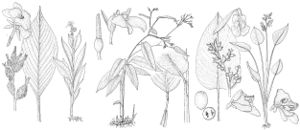Canna
Sp. Pl. 1: 1. 1753; Gen. Pl. ed. 5; 1, 1754.
| Taxon | Illustrator ⠉ | |
|---|---|---|
 | Maranta arundinacea Canna flaccida Thalia dealbata | John Myers John Myers John Myers |
Herbs, rhizomatous, 1–2 [–5] m, forming small to large monotypic stands. Leaves green [bronze or magenta in hybrids and cultivars], often glaucous [lanuginose]; blade narrowly ovate to narrowly elliptic, 20–70 cm × 15–30 cm, base gradually or abruptly tapered, apex acute to acuminate. Inflorescences: peduncles green [magenta], often glaucous; bracts green [magenta], often glaucous; primary bracts to 30 cm, secondary bracts to 20 cm; floral bracts 0.5–3 × 0.3–1.5 cm, papery. Flowers nearly sessile, subtended by pedicel bract; sepals usually green [magenta], often less than half size of petals; petals sharply reflexed or not, green or brightly colored, 4–15 cm, generally shorter than staminodes; staminodes pale-yellow to deep crimson red; labellum 3–9 × 4–10 cm; ovary green [magenta]. Capsules brown, 1.5–6 × 2–4.5 cm, warty, becoming papery. Seeds 5–25 [–75] per capsule, medium to dark-brown or black, 4–10 × 4–8 mm.
Distribution
Tropical and subtropical Americas with some species naturalized and many cultivated hybrids
Discussion
Until recently taxonomists recognized more than 50 species in Canna, but that number has now been reduced to ten (P. J. M. Maas 1985; P. J. M. Maas and H. Maas 1988) based mainly on new concepts of biogeographical history, the extent of hybridization during cultivation, and the plasticity of morphological features, especially in the highly polymorphic species C. indica.
Little has been published regarding pollination of these plants. The two North American species with pale yellow flowers, Canna glauca and C. flaccida, flower at dusk and may be pollinated by hawkmoths. Several neotropical species with bright red or orange flowers are hummingbird-pollinated. Nectar, which accumulates at the base of the floral tube, is the apparent reward in all cases. Pollen is shed from the bisporangiate anther onto the adjacent style before the flower opens (secondary pollen presentation), which usually results in self-pollination; thus, greenhouse-grown plants readily set seed. The large seed size and lack of reward for potential animal dispersal agents suggests that seeds are dispersed by gravity and water. Seeds can germinate and produce reproductive shoots in a single growing season.
Both Canna flaccida and C. glauca, as well as several Central American species, are hosts to the larva of the skipper butterfly Calpodes ethlius (Cramer), ), which builds protective tents by folding or rolling the apices of the leaves.
The most common use of Canna by Europeans and North Americans is as ornamentals. Both the hybrids and some species are grown for their striking foliage and large, delicate flowers. Two hybrids commonly grown in both temperate and tropical zones are C. ×generalis L. H. Bailey and C. ×orchioides L. H. Bailey. The former is apparently a cross between C. indica and C. glauca, or C. iridiflora Ruiz & and Pavóon and the latter between C. ×generalis and C. flaccida (L. H. Bailey 1924; J. W. Donahue 1965). These hybrids are usually sterile, although they may persist in cultivation.
The seeds of Canna indica are used as beads (especially for rosaries) and in gourds to form rattles. The rhizomes are used to make a form of arrowroot. The vegetation and rhizomes have been used as medicinals for both humans and domesticated animals.
Species 10 (3 in the flora).
Selected References
Lower Taxa
Key
| 1 | Plants not glaucous; flowers red to yellow-orange, but never pure yellow (except in some hybrid cultivars) | Canna indica |
| 1 | Plants glaucous; flowers pure yellow. | > 2 |
| 2 | Inflorescence simple with fewer than 5 flowers; sepals 2.5–3.5 cm; petals strongly reflexed; staminodes broadly ovate, labellum broadly obovate, 8–9 cm wide; seeds nearly globose, less than 7 mm | Canna flaccida |
| 2 | Inflorescence simple or occasionally branched with more than 10 flowers; sepals 1–2 cm; petals erect; staminodes narrowly elliptic to narrowly ovate, labellum linear, 0.7 cm wide; seeds ovoid, more than 7 mm | Canna glauca |